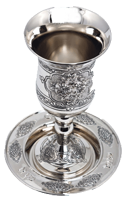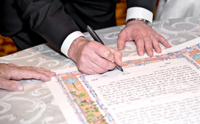How to Perform a Jewish Wedding
 Jewish weddings are full of beautiful and meaningful ceremonies that signify the start of the bride and groom’s life together. The wedding day has, in fact, been likened to a personal Yom Kippur for the couple involved where they rid themselves of all the negativity accumulated in their daily lives and start fresh.
Jewish weddings are full of beautiful and meaningful ceremonies that signify the start of the bride and groom’s life together. The wedding day has, in fact, been likened to a personal Yom Kippur for the couple involved where they rid themselves of all the negativity accumulated in their daily lives and start fresh.
Jewish weddings rituals start a week before the wedding with Kabbalat Panim, the tradition that bride and groom cannot see each other until the marriage ceremony. On the wedding day, during which they will both fast until the ceremony has been completed, they dress in their wedding finery, with the groom wearing the traditional Yom Kippur white kittel robe, and they greet their guests separately. At Ashkenazi weddings, their mothers break a plate together, emphasizing the gravity of the situation and implying that a shattered relationship can’t be mended.
The Badeken ritual is then performed and the groom puts the bride’s veil on her, which is a tribute to her modesty and innocence and which is also meant to encourage the guests to think about inner qualities instead of physical appearances. The couple then takes their place under the chuppah, or marriage canopy, which is open on all sides. In Ashkenazi custom, the bride then circles the groom seven times, indicating that she is building their home, and then stands to the groom’s right.
The rabbi then recites the betrothal blessings after which the bride and groom drink a celebratory cup of wine to bless the betrothal, which is also known as Kiddushin. Jewish law dictates that a marriage is not legal until the groom gives the bride a valuable object, which is usually a ring. Jewish wedding rings are plain gold and it is at the moment that the groom gives the ring to the bride and says “Behold, you are betrothed unto me with this ring, according to the law of Moses and Israel.”, that the wedding is officially consecrated.
 The jewish marriage contract, or ketubah, is then read – in the original Aramaic – and this sets out the groom’s future responsibilities towards his bride. Two witnesses sign the ketubah, which the new wife will keep all her life, and this comprises the end of the first part of the wedding ceremony. The couple now moves from the Kiddushin to the Nissuin – from the betrothal to the marriage – and the rabbi recites Shiva Brachot, the 7 blessings, after which the bride and groom drink from a second cup of wine.
The jewish marriage contract, or ketubah, is then read – in the original Aramaic – and this sets out the groom’s future responsibilities towards his bride. Two witnesses sign the ketubah, which the new wife will keep all her life, and this comprises the end of the first part of the wedding ceremony. The couple now moves from the Kiddushin to the Nissuin – from the betrothal to the marriage – and the rabbi recites Shiva Brachot, the 7 blessings, after which the bride and groom drink from a second cup of wine.
The groom then stamps on and shatters a glass on the floor, which symbolizes the destruction of the Temple in Jerusalem and the couple’s solidarity with the Jewish peoples, and this signifies the end of the wedding. The bride and groom are then escorted from under the chuppah by their friends and family to heartfelt cries of Mazel Tov. In some ceremonies, the couple is then taken to the yichud room, a private space where they can be alone together for the first time as man and wife and also have something to eat.
And now all that remains is for the new husband and wife to enjoy themselves at their wedding party, which usually features hearty food, dancing and festive entertainments. After completing the meal, they will say grace, the Birkat Hamazon, and listen to another recitation of the 7 blessings. During the week after the wedding, the couple will be treated to celebratory dinners by friends and family.
Jewish wedding rituals embody the beauty and permanence of the new relationship in a way that is wonderfully rich in tradition.
For a more in depth guide to performing a Jewish wedding the Wedding Rites by Micheal Foley.




